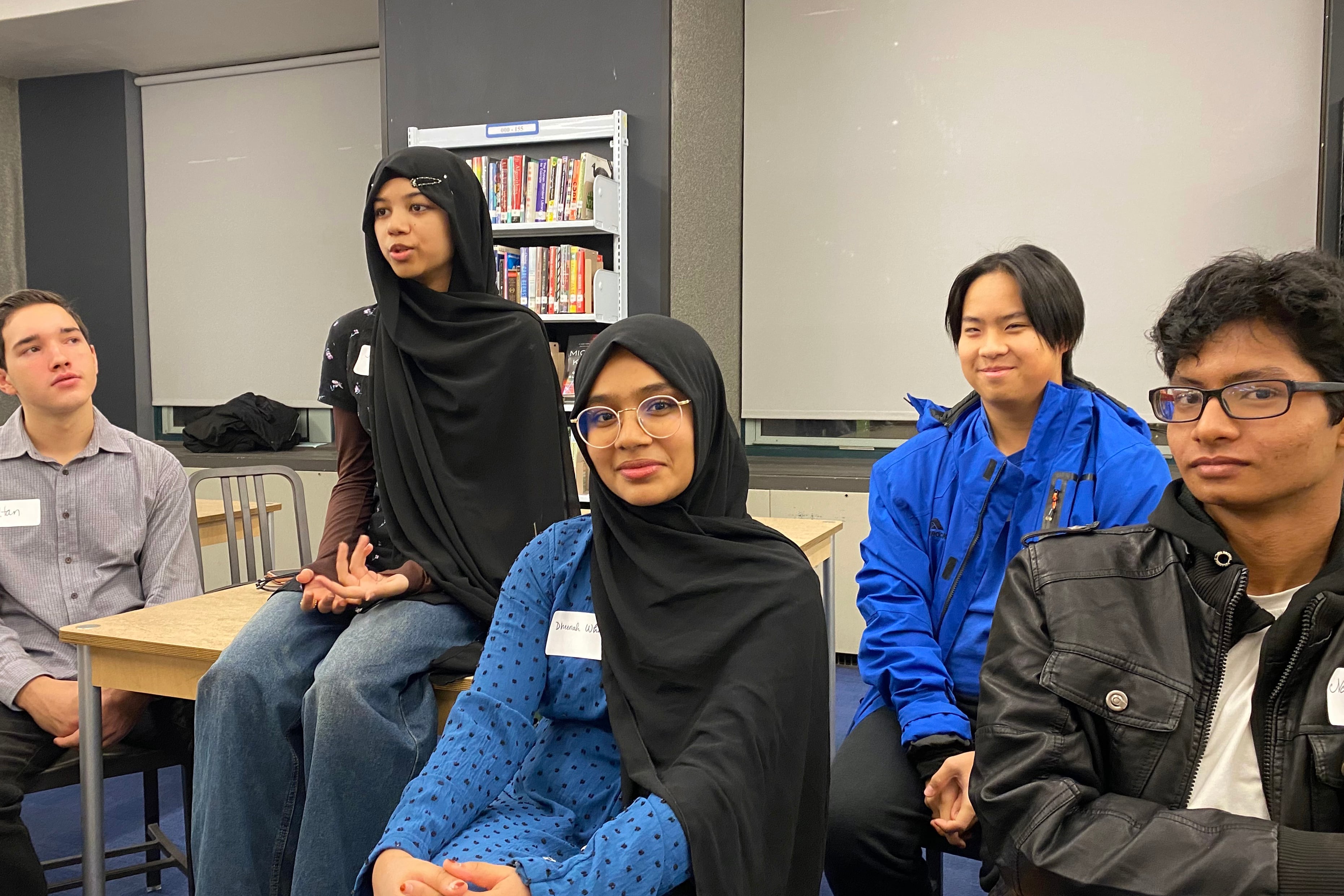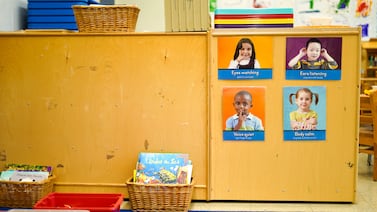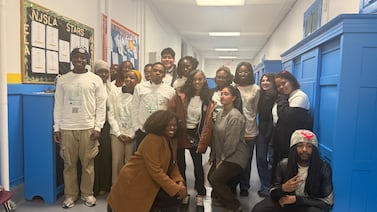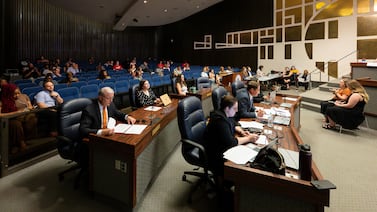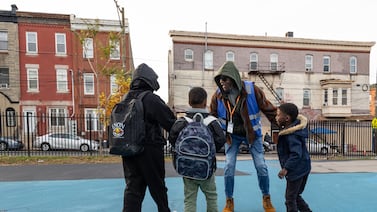Sign up for Chalkbeat New York’s free daily newsletter to get essential news about NYC’s public schools delivered to your inbox.
In Stuyvesant High School’s sixth-floor library, about a dozen students brainstormed how to raise money to buy equipment or assistive technology for students with disabilities.
They talked about whether artificial intelligence should be used in diagnosing cognitive differences (they decided against that). They discussed their ongoing project to examine language used in special education. They even delved into the debate between nature versus nurture.
In some ways, it was just another Thursday at Stuyvesant High School, where after-school clubs were abuzz with activity before the winter break.
But this was the first club of its kind at Stuy — and the largest such club in city schools focused on fostering an inclusive environment for students of all abilities.
StuySPICE is one of about 90 disability affinity, disability pride, and inclusion clubs in a network formed this school year through the Education Department’s new Division of Inclusive and Accessible Learning in partnership with the Neurodiversity Alliance, a nonprofit founded for and by students with learning differences. Another five are in the pipeline following the Education Department’s “inclusive learning” training sessions, officials said.
Two public school alumni serving on the Special Education Advisory Council, Victor Edwards and Joshua Stern, pushed for the citywide rollout of pride clubs, which are open to all students at a school, as a way to raise more awareness around ableism and exclusion of students with disabilities in school communities. Modeled on gender and sexuality alliances, these new student clubs aim to bolster a sense of belonging and community for students with disabilities, whether or not they have diagnoses or receive special education support through individualized education programs, or IEPs, or have accommodations through 504 plans.
StuySPICE — which stands for students promoting inclusivity and civic engagement — is the largest such club in the network, Education Department officials said. Its meetings average about 30 kids each week, with a high of 96 students coming to its early December gathering, Dheenah Whaqid, the club’s founder and Stuy junior said, emphasizing that all students were welcome.
“We don’t believe that you need to be diagnosed with an IEP or a 504 to believe that you have a cognitive-like difference,” she said.
The club’s seed was planted when Whaqid was in eighth grade, and she participated in the Education Department’s disability pride month art contest. She began learning more about the Americans with Disabilities Act, watching a video about 1990’s “Capitol Crawl” when more than 1,000 people marched to the capitol building, some of them ditching their wheelchairs to crawl up the steps in their push for the ADA.
“I made it a mission that as soon as I went to high school, I was going to start something to help people with disabilities,” Whaqid said.
In her sophomore year, Whaquid emailed Christina Foti, deputy chancellor for the inclusive learning division, about starting a club at Stuy, and got connected to Education Department staffers. They provided support to help get it off the ground last year, making it one of the original “pioneers” in the newly formed inclusive schools clubs network, Whaqid said.
Number of students with disabilities increasing at Stuyvesant
In some ways, the club’s popularity at Stuyvesant might not be surprising. The school is famous for its plethora of clubs and incredibly engaged student body.
But Stuyvesant isn’t a school known for having a robust special education program. In fact, the school, like the seven other specialized high schools that require a test as the sole means of entry, has among the city’s lowest percentage of students classified with disabilities.
Things, however, are beginning to change.
In the 2019-20 school year, just 15 students at the school were classified as having disabilities and receiving special education services, according to public data. This year, there are 61 such students, Education Department officials said. Another 96 students receive accommodations through 504 plans.
Last year, Stuyvesant brought on Gina Paulson as assistant principal overseeing student support services, including those receiving mandated special education services through IEPs or other accommodations through 504 plans.
Paulson, who previously worked as an assistant principal at Brooklyn Tech, has made herself accessible to families and discloses her own background as someone with dyslexia to her students. She is also the faculty advisor for StuySPICE.
Under her guidance, the school has been ramping up services. This year, she brought a speech therapist on staff for the first time. (Previously, Stuy students who needed speech services had to get vouchers from the Education Department and find their own providers outside of school. Students still have to do that for other related services.) The school, which serves nearly 3,300 students, has three special education teachers, according to budget documents. Five years ago, the school had no special education teachers, budget documents show.
Stuyvesant has been identifying more students who did not enter the school with an IEP or 504 and starting the process to identify support they might need, Paulson said.
Students might need support related to executive functioning, attention, or social-emotional skills, for example, that may not have been evident until they arrived at the school, she said. The school might need historical information about a student’s prior performance and might require supplemental diagnostic testing, such as speech or assistive technology evaluations.
“Identifying students’ learning needs in high school can be very difficult and requires a great deal of parent involvement and support,” she said.
Students don’t need to have or disclose disability to be in club
Two students who showed up to the club on Thursday for the first time — one with an IEP and another with a 504 plan — explained why they hadn’t come before: They were often taking tests on which they were allowed extra time.
“I feel like we’re in a very supportive environment where people are very understanding,” said a student who came late to the club because of a test that afternoon. “I’ll tell people like that I have to take tests after school because I have a 504, and they’re like, ‘Oh OK, cool.’ My biggest complaint is the scheduling thing.”
The student with the IEP also felt that the club created an inclusive environment, but he had general concerns that the language the school system uses around special education made it hard to understand by students who don’t receive services — and even those that do.
“It’s the use of very long words or just these acronyms,” he said listing IEPs, 504, and SETSS, for example. “Do you know what SETSS stands for, or how it’s even spelled?” he asked the group. (Special education teacher support services involve targeted support a special education teacher provides in a small group or one-on-one setting either by pushing into a classroom or pulling students out of class.)
When he first said that he had SETSS, Whaqid thought he was doing something related to constructing theater sets, she said.
Though students in StuySPICE are not asked to disclose whether they have a disability they are welcome to share so if they choose.
One student talked about her mother’s experience as a paraprofessional working with students with disabilities. Another talked about her grandfather, who is deaf.
Whaqid discussed how she views neurodiversity as an expansive concept, saying that many people might feel like they’re different but not have a diagnosis, or they might have a diagnosis but not want to share.
“We’re trying to create an inclusive community,” she said, “and help everybody feel included while getting ideas on how to improve the community.”
Amy Zimmer is the bureau chief for Chalkbeat New York. Contact Amy at azimmer@chalkbeat.org.

